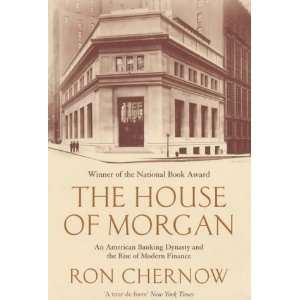
The last thing this world needs is another comment on the London Whale, but I’ve been silent on the topic for over a year, and today’s announcement that JP Morgan will pay $920 million in penalties, plus offer an apology, inspired a few quick thoughts.
The settlement is meaningless, as punishment
All along, the London Whale narrative of the past 1.5 years has been a scarcely concealed proxy fight over the so-called Volcker Rule, namely the idea that investment banks may, or may not, have to get out of the proprietary trading business, as a result of Dodd-Frank.
To the extent the London Whale position started out as a risk-reducing hedge, later became a profitable proprietary position, and then still later an unprofitable proprietary trade, it serves as a nice specific example for critics of proprietary trading to embarrass the pro-proprietary trading side of the argument.
Prop trading losses are self-correcting
What should not require explanation, but I think does, is that fact that proprietary trading losses already offer efficient argument against bad risk management in proprietary trading. When a bank loses money in prop trading, you really don’t need to fine the bank for losing its own money.
Proprietary trading losses are a self-correcting thing.
JP Morgan reportedly took a $6.2 Billion write-down against the position. The traders were fired, the risk managers were fired.[1]
As the SEC, you really don’t need to pile on an extra $920 million in fines to rub JP Morgan’s little doggy nose in the mess it made. They got the message already, a year ago.[2]
All that happens when Wall Street folks see this kind of gratuitous SEC enforcement action is that they roll their eyes and think to themselves, “the regulators don’t get it.”
“But JP Morgan admitted wrongdoing, so there must have been bad behavior, right?”
Wrong. JP Morgan admitted to an “SEC violation.”
In a new precedent set within the past year, banks now have to admit wrongdoing when they settle something like this, because that’s the new SEC mode. But the admission itself is silly as an SEC violation.
Their admission was that senior management didn’t tell members of the audit committee of the board of JP Morgan about the extent of losses from the trade in a timely fashion. Seriously, that’s the admission.[3]
So let’s think about that SEC violation. That’s also a self-correcting mechanism. If the board is bent out of shape about senior management’s ‘failure to timely inform them,’ its pretty easy to correct that problem. They can just fire the CEO. That’s the board’s job and the board’s right, and they haven’t exercised that right at this time. Which means they are fine with management, and Jamie Dimon in particular.
Protecting not widows and orphans, but JP Morgan’s audit committee of the board
The SEC’s role in protecting the board audit committee is really a silly kind of ‘SEC violation’ that isn’t necessary. The SEC was not talking about protecting widows and orphans from bad banks. The SEC was talking about protecting JP Morgan’s board members from the bank’s senior management.[4]
The senior management, incidentally, serves at the board’s pleasure. So in essence the SEC was protecting the bosses (the audit committee of the board) from their employees (Dimon and his team).
“But ‘banks = bad,’ so I like it whenever the government sticks it to The Bad Man”
Grrr.
Banks need to be regulated of course, but banks need to be regulated in ways that aren’t gratuitous or done for excessively symbolic reasons.
This SEC enforcement action is nothing but a big, unnecessary proxy action for the Volcker Rule fight.
Wall Street knows this, JP Morgan knows this, and they’re willing to lose this battle in order to win the larger war regarding proprietary trading.
Ultimately it’s about respect for the rule of law
In the long run, symbolic and gratuitous enforcement actions[5] weaken respect for the rule of law.
As in: We (the government) pretend to have found something wrong and you (the bank) pretend to be contrite for doing something that you do in the ordinary course of business. With each of these pretend enforcement actions, over time you whittle away at any respect the bank may have had for its regulators.
With each of these pretend enforcement actions the question in bank management’s mind is less “How can we be better stewards of our industry?” and more “Ok, just tell me how much this is going to cost me, to make this regulator temporarily go away?”
At some level regulators know this, and they know they can make a big high-dollar score against the finance industry. Elected officials certainly know this, and can work the delicate game of being useful, in the right circumstances and with the right industry support, at key moments. All of this is not a move in the right direction.
The London Whale penalty, in the long run, is a victory for nobody.
[1] Jamie Dimon of course was not fired, because he’s Jamie Freaking Dimon.
[2] And incidentally, while the headlines losses are nominally big, they are immaterial to the operation of JP Morgan overall. At no point has anyone even remotely believed that the London Whale losses matter existentially to JP Morgan. The bank is fine.
[3] And frankly there’s a good-to-overwhelming probability that senior management themselves had no way of knowing the extent of the losses at the time. The position was still on, and markets move, and losses may get bigger or smaller. You don’t know until you completely unwind the position.
[4] Just for fun, who exactly is the SEC protecting, on the audit committee of the board? James Bell, former Boeing executive, and board member also of Dow Chemical; Crandall Bowles, Chairman and former CEO of Spring Industries and member of the board of the Brookings Institution, The Wilderness Society, and the Packard Center for ALS Research at Johns Hopkins; and Laban Jackson, the Chairman of Clear Creek Properties, Inc., director of Markey Cancer Foundation, director of the Federal Reserve Bank of Cleveland, and former director of The Home Depot. I think these people can defend themselves.
[5] something Eliot Spitzer made a career of and rode all the way to the NY Governor’s office
Post read (11994) times.



